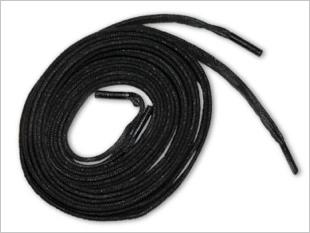This week's tip:
The Laws of Lacing
Four rules for skate laces
By Trish Alexander

Skate laces
During her inglorious career, figure skater Tonya Harding provided the world with several cautionary tales, most notably the one about how it's not a good idea to hire thugs to break the legs of your rivals.
Another lesson she gave us concerned the importance of taking care of our laces. Just before the start of her free skating program at the 1994 Olympics, she snapped a lace and — lacking a proper replacement lace — almost missed her turn on the ice.
Of course, laces were the least of Tonya’s problems. But to help you avoid lace disasters of your own, here are four time-tested tips for laces and lacing:
1) Double tie your laces.
Most skaters use a simple bow knot to tie their skates, the same knot we use to tie our shoes. But bow knots can — and often do — come loose. That’s usually not a big deal if you are walking in street shoes. But on skates, a loose lace can get tangled in your wheels, causing them to stop and you to fall.
Fortunately, it’s easy to prevent your laces from coming loose. Simply double knot them. It’s easy to do and it only takes a couple of seconds. Just loop one of the “ears” around the other and give both ears a pull.
2) Cut 'em in half.
Sometimes, you can get a better, more comfortable fit if you use two laces per skate. This is especially true for fitness and urban skaters, though some speed skaters also favor two laces.
If you want to try two laces, use one lace over the top of your foot and the second for the cuff. This allows you to adjust the tightness of the different sections of your skate. Most skaters like the laces tighter over their foot and looser around their ankles.
With two laces, you can also skip the eyelets over the joint between your foot and leg. Some skaters find this more comfortable.
3) Buy a lace tightener.
If your skates feel loose, maybe they are too big. Or maybe you are not tightening your laces enough.
If so, try using a lace tightener or lace hook. Ice skaters swear by them. And they work great. Just make sure you don’t tighten your skates so much that you get blisters.
4) Check your laces regularly.
Before you put on your skates, inspect your laces. Are they fraying or otherwise showing signs of wear? If so, replace them immediately. Don’t wait for them to break — or, like Tonya, you may be late for your Olympic moment.
...
 Trish Alexander is the head of the Skate IA and director of the Skate Journey Skate School in Bellevue, WA. She started ice skating as a child and was a competitive figure skater as a pre-teen. She started inline skating in 1994 and began teaching two years later. She is certified to teach Level I, Level II, Master Fitness, Blade Fitness and Fitness Inline Marathon Training. In a former life, she was a paralegal and private detective.
Trish Alexander is the head of the Skate IA and director of the Skate Journey Skate School in Bellevue, WA. She started ice skating as a child and was a competitive figure skater as a pre-teen. She started inline skating in 1994 and began teaching two years later. She is certified to teach Level I, Level II, Master Fitness, Blade Fitness and Fitness Inline Marathon Training. In a former life, she was a paralegal and private detective.